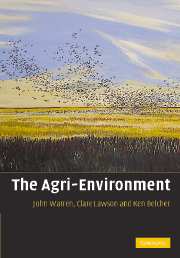Book contents
- Frontmatter
- Contents
- Preface and Acknowledgements
- 1 An introduction to agro-ecology
- 2 Agricultural support and environmentalism
- 3 Environmental impacts of agriculture
- 4 Principles behind agri-environment schemes
- 5 Farm conservation planning
- 6 Habitat management
- 7 The management of agricultural wastes
- 8 Low-impact farming systems
- 9 Landscape and farmscape ecology
- 10 The future of agri-environmental systems
- Glossary
- References
- Index
10 - The future of agri-environmental systems
Published online by Cambridge University Press: 08 December 2009
- Frontmatter
- Contents
- Preface and Acknowledgements
- 1 An introduction to agro-ecology
- 2 Agricultural support and environmentalism
- 3 Environmental impacts of agriculture
- 4 Principles behind agri-environment schemes
- 5 Farm conservation planning
- 6 Habitat management
- 7 The management of agricultural wastes
- 8 Low-impact farming systems
- 9 Landscape and farmscape ecology
- 10 The future of agri-environmental systems
- Glossary
- References
- Index
Summary
Introduction
Agriculture has historically been location specific. The variability of climate, soil, topography and culture across a landscape resulted in a diverse and locally distinctive agriculture. During the twentieth century the Green Revolution saw dramatic increases in agricultural productivity and a more science-based agriculture with greater control of production factors such as chemical fertilisers, pesticides and machinery. Accompanying and, in many cases, supporting these changes was an increase in state subsidisation of agriculture, both direct production support and indirect support through research and development. This led to a decrease in location-specific agriculture and to more of a centralised or ‘blueprint’ agriculture driven by production targets (Fresco, 2002). What will agriculture and rural landscapes look like in the future? The final chapter of this book will consider the future of agricultural systems. Will agriculture be transformed to systems that integrate environmental protection and food production across the landscape to provide society with both food and fibre commodities and a wide range of ecological goods and services? Alternatively, will a more location- or region-specific system emerge with certain areas of land, and other resources, allocated to intensive production of food and fibre commodities, while farmers/managers in other areas focus on the production of ecological goods and services? Ecological theory suggests that in future more biodiverse agricultural systems may be more sustainable and productive than the monocultures that currently dominate agricultural landscapes around the world. However, there are considerable practical problems to overcome.
- Type
- Chapter
- Information
- The Agri-Environment , pp. 180 - 195Publisher: Cambridge University PressPrint publication year: 2007



